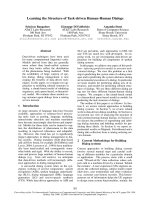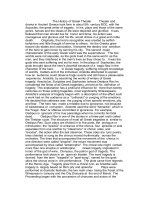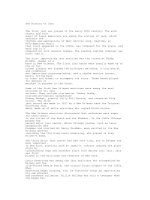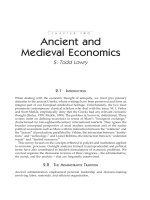Writing task 2 9.0 9999 learning the history of ones building
Bạn đang xem bản rút gọn của tài liệu. Xem và tải ngay bản đầy đủ của tài liệu tại đây (184.36 KB, 8 trang )
Overall band score
9
9+9+9+9
See below C&C LR GRA
Model answer
WRITING TASK 2
You should spend about 40 minutes on this task.
Write about the following topic:
In some countries, more and more people are becoming interested in finding out
about the history of the house or building they live in.
What are the reasons for this?
How can people research this?
Give reasons for your answer and include any relevant examples from your own
knowledge or experience.
Write at least 250 words.
Original answer There is an increasing trend towards people seeking to uncover the history of
their homes or buildings. This essay will first outline the underlying causes of this
curiosity, before giving some methods that people can employ to conduct such
research.
To begin with, the growing interest in discovering the past of one's residence or
building can be attributed to two main reasons. One of these is the desire to
establish a deeper connection with the past. By understanding the historical
context and the lives of previous occupants, individuals can gain a sense of
belonging and continuity, fostering a stronger emotional attachment to their
living spaces. Another reason can be the potential for financial gain. Unearthing
valuable information about a property, such as architectural significance or
noteworthy previous inhabitants, can increase its market value and appeal to
potential buyers, particularly in the case of heritage properties.
For those seeking to delve into the history of their dwelling, there are several
ways to conduct research. The first approach involves consulting local archives,
such as city or county records, which may contain information on the property's
construction date, original owner, and any major alterations or events that took
place there. These documents can provide a wealth of information on the
property's past. In addition to this, people can also explore oral history by
speaking with long-time residents of the area or previous occupants of the
building. These individuals can provide firsthand accounts and anecdotes, possibly
offering invaluable insights into the property's history.
To summarize, the increasing desire to understand the history of one's home or
building stems from the desire for emotional connection and potential financial
gain. By utilizing resources such as local archives and oral history, individuals can
uncover the past of their living spaces.
Overall band score
9
9+9+9+9
TR – Task Response nb – GRA and LR errors have not been corrected
Band score 9
This is a difficult question – they’re asking you to explain something that doesn’t
happen – or something that happens pretty infrequently, so you have to pretend
that it’s really a thing people do, which you did well.
Just like in similar questions about researching family history or local history, I
would probably say they do it primarily out of interest, although the reasons you
cited are feasible. There’s also the possibility that the researcher’s family has
occupied the property for a long time, which would certainly provide adequate
motivation.
You have a clear position throughout and all parts of the question are addressed.
Your position is coherent and well-argued. The ideas are relevant, extended, and
coherent.
Advice On Brainstorming For Task 2
As you’re planning and writing your answer, remember to constantly
ask yourself if you’re answering the question. Check back to the
question a few times as you think of ideas to make sure they're
directly relevant.
Make sure your introduction directly addresses the
question.
Make sure your ideas address all parts of the question. If
the question asks for solutions, in the plural, you must
suggest at least 2.
Make sure your main ideas, as stated in the first sentence
of the main body paragraphs, are directly relevant to the
question.
Make sure your supporting ideas, which follow the main
ideas in the main body paragraphs, directly support the
main idea.
Be especially careful if you’ve answered similar question
before, as there will always be important differences.
Make sure your conclusion directly answers the question,
that it is consistent with the ideas in the main bodies, and
that it does not contradict the introduction.
There is an increasing trend towards people seeking to uncover the history of
their homes or buildings. This essay will first outline the underlying causes of this
curiosity, before giving some methods that people can employ to conduct such
research.[a]
To begin with, the growing interest in discovering the past of one's residence or
building can be attributed to two main reasons[b]. One of these is the desire to
establish a deeper connection with the past. By understanding the historical
context and the lives of previous occupants, individuals can gain a sense of
belonging and continuity, fostering a stronger emotional attachment to their
living spaces. Another reason can be the potential for financial gain. Unearthing
valuable information about a property, such as architectural significance or
noteworthy previous inhabitants, can increase its market value and appeal to
potential buyers, particularly in the case of heritage properties.[c]
For those seeking to delve into the history of their dwelling, there are several
ways to conduct research. [d]The first approach involves consulting local archives,
such as city or county records, which may contain information on the property's
construction date, original owner, and any major alterations or events that took
place there. These documents can provide a wealth of information on the
property's past. In addition to this, people can also explore oral history by
speaking with long-time residents of the area or previous occupants of the
building. These individuals can provide firsthand accounts and anecdotes, possibly
offering invaluable insights into the property's history.[e]
To summarize, the increasing desire to understand the history of one's home or
building stems from the desire for emotional connection and potential financial
gain. By utilizing resources such as local archives and oral history, individuals can
uncover the past of their living spaces.[f]
C&C - Cohesion and Coherence nb GRA and LR errors have not been corrected
Band score 9
Excellent cohesion and coherence throughout, with no errors.
The sentences have a natural flow characteristic of high band score answers.
Paragraphing for Task 2
I recommend you write 4 paragraphs as follows:
Write an introduction, that explains what the question is.
After reading the introduction, the reader should have a
good idea what the essay is about, and what your position
(opinion) is. It should be possible to write an introduction in
under 50 words. It is not necessary to write a long
background statement.
Write 2 main body paragraphs. This should allow you to
expand on the ideas sufficiently to persuade the examiner
that you’ve fully supported the main ideas. If you write 3
main bodies, it is more difficult to expand and support them
sufficiently to get a high score.
If it’s a two-part question, answer the questions in the order
they’re given and write one paragraph per question.
The main body paragraphs should be 100-120 words, and
each paragraph should have a clear topic sentence and 2 or
more supporting ideas which support the topic sentence with
reasons, evidence, and examples. Do not waste time with
lots of background information.
The topic sentences should directly address the question.
The conclusion should be consistent with the introduction
and the main ideas, and it should not introduce new ideas. It
should directly answer the question. Do not leave the
examiner in any doubt about whether you’ve answered the
question.
If you write a third paragraph in a discuss both sides question
to clarify your position, make sure to give a good reason to
reject one of the sides. If you just restated the original ideas
about one side, the examiner may decide you have covered
one side more than the other.
It is also ok to write a third body paragraph in a to what
extent question if you have main ideas which both agree and
disagree with the proposition. Avoid short paragraphs, with
under 70 words, as it may be difficult to show a clear central
topic in a short paragraph.
There is an increasing trend towards people seeking to uncover the history of
their homes or buildings[g]. This essay will first outline the underlying causes of this
curiosity, before giving some methods that people can employ to conduct such
research.
To begin with, the growing interest in discovering the past of one's residence or
building can be attributed to two main reasons. [h]One of these is the desire to
establish a deeper connection with the past. By understanding the historical
context and the lives of previous occupants, individuals can gain a sense of
belonging and continuity, fostering a stronger emotional attachment to their
living spaces. Another reason can be the potential for financial gain. Unearthing
valuable information about a property, such as architectural significance or
noteworthy previous inhabitants, can increase its market value and appeal to
potential buyers, particularly in the case of heritage properties.[i]
For those seeking to delve into the history of their dwelling, there are several
ways to conduct research[j]. The first approach involves consulting local archives,
such as city or county records, which may contain information on the property's
construction date, original owner, and any major alterations or events that took
place there. These documents can provide a wealth of information on the
property's past. In addition to this, people can also explore oral history by
speaking with long-time residents of the area or previous occupants of the
building. These individuals can provide firsthand accounts and anecdotes, possibly
offering invaluable insights into the property's history.[k]
To summarize, the increasing desire to understand the history of one's home or
building stems from the desire for emotional connection and potential financial
gain. By utilizing resources such as local archives and oral history, individuals can
uncover the past of their living spaces.
LR- - Lexical resource nb Some GRA errors have not been corrected
Band score 9
Vocabulary is used accurately with sufficient flexibility to show precise meaning,
with a wide variety of vocabulary, used accurately and with a high level of control.
There is an increasing trend towards [l]people seeking to uncover the history of
their homes or buildings. This essay will first outline the underlying causes of
this curiosity[m], before giving some methods that people can employ to conduct
such research.
To begin with, the growing interest in discovering the past of one's residence or
building can be attributed to two main reasons[n]. One of these is the desire to
establish a deeper connection with the past. By understanding the historical
context and the lives of previous occupants, individuals can gain a sense of
belonging and continuity, fostering a stronger emotional attachment to their
living spaces. Another reason can be the potential for financial gain. Unearthing
valuable information about a property, such as architectural significance or
noteworthy previous inhabitants, can increase its market value and appeal to
potential buyers, particularly in the case of heritage properties.
For those seeking to delve into the history of their dwelling[o], there are several
ways to conduct research. The first approach involves consulting local archives,
such as city or county records, which may contain information on the property's
construction date, original owner, and any major alterations or events that took
place there. These documents can provide a wealth of information on the
property's past. In addition to this, people can also explore oral history by
speaking with long-time residents of the area or previous occupants of the
building. These individuals can provide firsthand accounts and anecdotes, possibly
offering invaluable insights into the property's history.
To summarize, the increasing desire to understand the history of one's home or
building [p]stems from the desire for emotional connection and potential financial
gain. By utilizing resources such as local archives and oral history, individuals can
uncover the past of their living spaces.
GRA – Grammatical range and accuracy nb Some LR errors have
not been corrected
Band score 9
Grammar is used accurately with a wide variety of structures, which should be
good for a band score 9.
Punctuation is use correctly throughout.
Appropriate structures are used throughout.
There is an increasing trend towards people seeking to uncover the history of
their homes or buildings. This essay will first outline the underlying causes of this
curiosity, before giving some methods that people can employ to conduct such
research.
To begin with, the growing interest in discovering the past of one's residence or
building can be attributed to two main reasons. One of these is the desire to
establish a deeper connection with the past. By understanding the historical
context and the lives of previous occupants, individuals can gain a sense of
belonging and continuity, fostering a stronger emotional attachment to their
living spaces. Another reason can be the potential for financial gain. Unearthing
valuable information about a property, such as architectural significance or
noteworthy previous inhabitants, can increase its market value and appeal to
potential buyers, particularly in the case of heritage properties.
For those seeking to delve into the history of their dwelling, there are several
ways to conduct research. The first approach involves consulting local archives,
such as city or county records, which may contain information on the property's
construction date, original owner, and any major alterations or events that took
place there. These documents can provide a wealth of information on the
property's past. In addition to this, people can also explore oral history by
speaking with long-time residents of the area or previous occupants of the
building. These individuals can provide firsthand accounts and anecdotes, possibly
offering invaluable insights into the property's history.
To summarize, the increasing desire to understand the history of one's home or
building stems from the desire for emotional connection and potential financial
gain. By utilizing resources such as local archives and oral history, individuals can
uncover the past of their living spaces.









